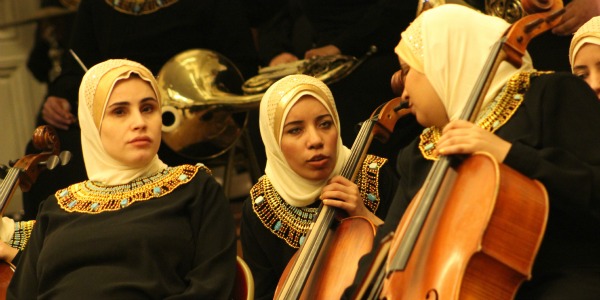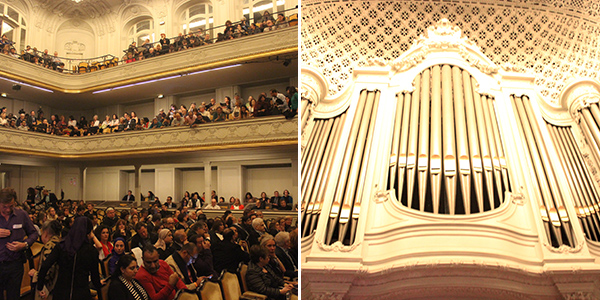Al Nour Wal Amal Chamber Orchestra probably needs no introduction. Consisting of visually impaired and completely blind female musicians for over four decades, the orchestra has built a strong reputation in Egypt and internationally and travelled across five continents and dozens of countries.
Called by the audiences and critics alike “the fourth pyramid of Giza,” “the human miracle,” and “the ambassadors of Egypt,” it is safe to say that Al Nour Wal Amal orchestra, part of the Association with the same name, spreads light with music. True musicians and wonderful humans, the orchestra’s distinctiveness lies in their craftsmanship, determination and creation of wonders against all odds: the orchestra members overcome their impairment with music offering unforgettable experience to listeners around the world.
Al Nour Wal Amal’s basic repertoire includes Western classical music compositions – Mozart, Rossini, Verdi, Bizet, Brahms and many other great names – topped with a few works from renowned Egyptian and Arab composers, among them Abou-Bakr Khairat, Rageh Dawood, Riyad El-Sonbaty, Aly Abdel Sattar. At the same time, and particularly during their travels, they often add a performance of a work linked to the visited country.
Though the orchestra is always welcomed with high acclaim and passionate ovations from audiences worldwide, the recognition given to the musicians is not an act of flattery – or compassion – offered to the visually impaired ladies but rather expresses a truthful appreciation of the effort and the music proficiency that the orchestra represents.
One of the most evident examples of the strength of Al Nour Wal Amal was showcased during their recent concerts, in Cairo and Paris, when the orchestra joined a performance of Days and Nights of the Heart Tree (Les Jours et les Nuits de l’Arbre Coeur) by French-Algerian writer and composer Tarik Benouarka.
Usually, in Egypt and internationally, the orchestra is conducted by Aly Osman who for many years also trained the musicians, yet for this specific performance, another Egyptian conductor Mohamed Saad Basha took the baton into his hand.

Tenor Ragaa El-Din and soprano Rasha Rizk in the Days and Nights of the Heart Tree performed at the Salle Gaveau in Paris, 5 November 2015. (Photo: Ati Metwaly)
The Days and Nights of the Heart Tree’s world premiere took place in Cairo, on 30 September at the Cairo Opera House, and then in Paris on 5 November at the Salle Gaveau.
Days and Nights of the Heart Tree consists of more than 20 segments grouped in 3 parts with the text that speaks about two people, a man and a woman, meeting to discover emotions. The composition also includes two soloists, soprano (Dalia Fadel performed in Cairo and Rasha Rizk in Paris) as the character of Amal and tenor Ragaa El-Din as Nour, choir, narrator (Assem Nagaty in Cairo and a Syrian actor in Paris) as well as video projections.
The composition begins with an overture and goes through pieces called Far Away, the Moon, Earth Flies, Waterfalls, Lira’s Suite, Sea of Constellation, the Time, the Land of Two Rivers, etc and reaches an epilogue.
As if following the motto underlined in the programme notes “Only the heart can see,” the composer has stretched this very same concept into an 80-minute-long composition that fuses Western orchestral components with oriental accents and melodies. The work’s division into separate pieces however is not supported with musical or dramaturgical buildup; it does not offer climax points, only a few similar themes and phrases that are repeated across all the segments.
On the other hand, neither the text nor the narrator pushes the dramaturgy forward; the narrator steps on the stage in between some segments to further discuss the emotional condition of the characters. The video stressed the yearnings with projections of water waves, wind within the trees, people joining arms, face of a woman, and so on.
As such, the Days and Nights of the Heart Tree is a simple linear expression and becomes a rather lengthy emotional argument that aims at creating a contemplative mood, pointing to values of life and feelings such as love and hope.

Women from Al Nour Wal Amal Orchestra chat before the concert at Salle Gaveau, Paris (Photo: Ati Metwaly)
With frail musical and dramaturgical backbone, categorization of the composition is equally puzzling. Benouarka describes Days and Nights of the Heart Tree differently to Cairo’s and Paris’s audiences, calling it a ballet-opera in the first performance and simply an opera in the latter one.
We understand that the term ballet in the work’s name refers to the French dancers who joined the performance in Cairo only, and for clearly visual reasons. The ballet presence on the stage is not embedded in the musical components of the work nor it is justified in musical and dramaturgical needs of the composition, hence removal of the dancers in Paris’s performance did not affect the artistic notions.
Ballet-opera, opera or operetta as some call it… Coining the genre of Benouarka’s composition is a challenge indeed, yet for the sake of sheer fun in the exercise of terminology, let us add a term ‘suite’ into the equation. Still, unlike many suites, Benouarka offers segments that resemble one another, at the verge of becoming almost similar in musical concept and techniques used.
Though the work does not lack soothing passages – even if expressed through simple melodies and plain orchestration – the text (the poetry) is as confusing as the musical side of the show. And though some critics cited in the programme found the magical moments in the composition, they definitely refer to the general atmosphere of an unsolved artistic enigma that the work delivers.
Music and dramaturgy aside, the problem, however, remained in the Parisian distribution of the set. The screen, the orchestra, the choir, the soloists (and the dancers)… the whole set worked well on the spacious stage of the Cairo Opera House but it proved challenging at the Salle Gaveau, which is a much smaller venue and as such can accommodate smaller ensembles.

Days and Nights of the Heart Tree performance at the Salle Gaveau, view from the theatre's ground floor (Photo: Ati Metwaly)

Days and Nights of the Heart Tree performance at the Salle Gaveau, view from the balcony (Photo: Ati Metwaly)
In Paris, the director Gilbert Desveaux benefited from the removal of the dancers; he placed the orchestra on the leveled structure stretching across the stage, keeping the choir in the far left wing and leaving the narrow area at the downstage for the soloists and the narrator.
In Cairo, the screen was but a large background and did not interfere with the artists on the stage. In Paris, the compact setting was, withal, visually compressed by the immense screen which descended low near the downstage (almost at the proscenium) reaching over the heads of the orchestra’s first row, partially covering the musicians in the back rows. As follows, for the audience seated at higher levels of the Salle Gaveau, on two balcony levels, the screen barrier visually compromised the theatrical depth and rendered several musicians invisible.
Here, it is worth mentioning that the screen also covered an impressive early-20th century organ that the Salle Gaveau is proud of. Shortly, not only have those unacceptable flaws in mise-en-scene and set jeopardised the whole performance, they did not give justice to the main stars of the evening: Al Nour Wal Amal Orchestra.
Despite the general sensation of visual density, the orchestra’s and the soloists’ musical integrity was not harmed by the unfortunate setting in Salle Gaveau. Both, Egyptian tenor Ragaa El-Din and Syrian soprano Rasha Rizk – both, Paris-based – are singers with thriving international careers. Ragaa El-Din and Rizk were definitely among the highlights of the evening, adding an attractive dimension to the voice lines.
It is important to add that throughout the whole performance, conductor Mohamed Saad Basha kept the visually impaired musicians in the lines of music, making sure that the whole composition was delivered with their best capacity.
And it is not difficult for Al Nour Wal Amal, a professionally trained orchestra to respond to all the challenges, be them musical or mise-en-scene and receive strong ovation at the end of their performance.
The Days and Nights of the Heart Tree was their first experience in which the orchestra moved outside the purely symphonic format, an important learning experience that allowed the musicians to interact with new artists and new concepts, communicate with them and in between each other on the values and challenges encountered.
It is definite that Benouarka’s material was not as demanding as many other works performed by this orchestra, even if they have spent many months preparing for this performance (a fact which sends us back to the structure and concepts of the composition). However, in the hands of Al Nour Wal Amal the final result was an impressive delivery of music, where in many sections, a uniform sound of strings created a rich fabric interlaced with well performed woodwind solos and sharpened with percussion colouring.
When the last note was played at the Salle Gaveau, the audience applauded the artists, the soloists, the narrator and the composer.
This is when the conductor started bringing to the proscenium consecutive section leaders in Al Nour Wal Amal orchestra. As the wonderful musicians bowed, the hall exploded in a rapturous ovation. Once again, the orchestra’s success was evident, as the visually impaired women delivered a memorable performance, against all odds.

Salle Gaveau in Paris: auditorium (L) and organ (R). (Photo: Ati Metwaly)
For more arts and culture news and updates, follow Ahram Online Arts and Culture on Twitter at @AhramOnlineArts and on Facebook at Ahram Online: Arts & Culture
Short link: